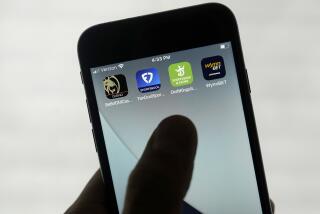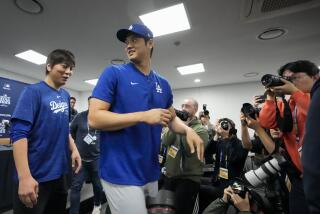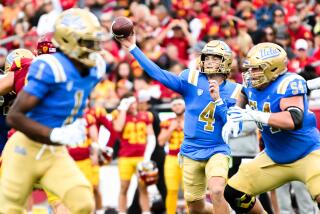The O’Bannon case: When, if ever, should college athletes get paid?
If you stop someone in the street and ask whether college athletes should be paid to play, the answer is likely to be “no.” Witness a recent Marist poll, which found that only 27% of the respondents felt that athletes deserved more than the scholarships and stipends they already receive.
But the lawsuits brought by former UCLA hoops star Ed O’Bannon Jr. and other former college athletes raise a different question and may elicit a different answer. Should athletes receive a share of the money colleges make by selling their performances and likenesses to the media?
The NCAA and regional sports leagues have extracted whopping and ever-increasing sums from the TV industry for the rights to broadcast their games. (Much of that money, incidentally, comes from the 90% of U.S. households that pay ever-higher monthly fees for cable or satellite TV.) To a great extent, that money is used to support college sports programs and the students who participate in them. So you could argue that athletes already are getting their fair share of the licensing dollars in the form of better gyms, larger coaching staffs and the like.
It’s also hard to imagine a workable licensing regime for televising college sports if every player on the team has a say over the use of the images. What would happen if a player refused to accept the deal that broadcasters offered? Would the coach have to leave her on the bench?
Still, there’s something unseemly about colleges profiting off of videogames whose players mimic current and past stars. California law is very protective of individual rights of publicity, requiring companies to obtain consent before exploiting a person’s image or likeness for commercial purposes. Yet student athletes have no say in the deals cut by their colleges (or alma maters, in the case of games based on great teams of yore), let alone a cut of the proceeds. That’s because colleges require them to sign over these rights in order to play.
The NCAA has denied that it licenses player likenesses. But O’Bannon and other plaintiffs contend that video game characters have been modeled after them well enough to make them recognizable, even without a name on the back of the jersey.
I don’t have a problem with colleges negotiating broadcasting rights and spending the proceeds without giving the players a voice or direct stake in the process. I do have a problem, though, when colleges monetize the likenesses or exploits of individual players, capitalizing on the brief celebrity that some players enjoy. That’s especially true for the revenue streams that games can generate for a school after the students have left. If a game features a character designed to look and move as, say, Kareem Abdul-Jabbar did when he was at UCLA (when he was known as Lew Alcindor), why shouldn’t the real Kareem reap at least some of the proceeds?
The legal issues need to be resolved soon because the Internet and portable devices are providing more avenues for colleges to turn their players into revenue streams. That’s why a federal judge in Oakland should grant the motion by O’Bannon and other college stars to certify the case as a class action -- not just for former players, but for current ones as well.
Yes, that would raise the stakes exponentially for the NCAA and other college sports bodies. But O’Bannon’s interests are the same as every other college player’s, current and former. The deal they’re handed -- trading away rights in exchange for the chance to play sports at a high level and prove their worth to the pros, typically while receiving a college education for free -- seems fair in many, but not all, respects. It’s worth deciding whether it passes legal muster, in whole or in part.
ALSO:
The soft sciences matter as much as ever
UC and Native Americans: Unsettled remains
Follow Jon Healey on Twitter @jcahealey
More to Read
A cure for the common opinion
Get thought-provoking perspectives with our weekly newsletter.
You may occasionally receive promotional content from the Los Angeles Times.







